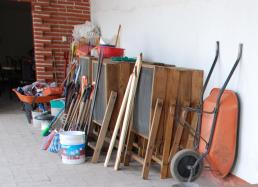9: The Lab
Our time in the lab is winding down as we prepare to pack and store our collections from this field season with those from our last. In line with our federal permit, our collections are stored here in Mitla in a facility that belongs to the Mexican National Institute of Anthropology and History (INAH). The facility is dry, locked, and guarded. Our responsibility is to pack all the materials in an orderly, documented fashion (see Photo #1 below) using well-labeled cartons that will be easy to retrieve in the future.
Over the past weeks, as we've been working in the lab, the weather has gone in a snap from dry to wet, and the countryside has changed from brown to different shades of green. The landscape is rapidly transforming, to the delight of those who still make their living farming and grazing. In Mitla, that lifestyle is rapidly dwindling, but most people still depend on water from their wells, so the onset of rain remains very welcome. The weather shift has coincided with dramatic changes in temperatures and cloud patterns.
After two months with almost no rain, we're now experiencing rain every day. And yet, relatively little of that moisture falls between 7 am and 4 pm. Nevertheless for now, the sun—so omnipresent for months—has taken a temporary vacation, and even when it's not raining, it seems that our sky is laden with clouds.
As I mentioned in last week’s dispatch, the rhythm of lab work entails long periods of methodical, grinding analysis, punctuated by occasional moments of stimulation and “eureka.” This week, we had one of those brief, exciting events when many of Mitla’s officials arrived at our lab without forewarning, with a cameraman and reporter from the Mexican television network, Televisa.
For an hour, Linda and I were peppered with rapid-fire questions (in Spanish, naturally) from the media and the governing officials alike as we displayed and discussed many of our key finds and interpretations. After this episode of buzzing activity, the lab returned to its usual quiet, studious state, and our crew returned to their respective jobs.
Besides the dramatic transition in the weather, our time in the lab has been marked by the beginning of two other cyclical happenings that have entranced Mitla from afar and that will continue for a brief time after our rapidly approaching departure. One is the World Cup, which is presently a central focus of national attention and conversation, especially when Mexico is (or was just) on the field. Mexico’s victory over France this week has dramatically boosted confidence here, while likely propelling Mexico’s national team (El Tri, as they are called here) into the next round.
The second set of events is the ongoing political campaign, which for Mitla includes the race for Oaxaca State Governor, a legislative election, and the local competition for Presidente Municipal (mayor). Signs of varying sizes and shapes have gone up all over town in support of the people vying for office, and several events in Mitla’s town square have been held to introduce the candidates to the local citizenry. The latter happenings, generally preceded by persistent announcements over loudspeakers attached to cars that repeatedly circle around town, have included fireworks, souvenir distributions, and, of course, the requisite speeches.
Speaking of sounds, one of things that I notice when in lab or town is the contrast in noises between being at the site and in the lab, and also how distinctive both sets of sounds are compared to life in the States. At the Fortress, the pervading sounds reflect the work, the rattle of screens, the clinking of small picks, and the chatter of the crew’s conversation. Otherwise, there is quiet, punctuated by bird calls, or a gust of wind, or the far off noises that emanate from the highway or even Mitla itself (several kilometers away).
In contrast, in town back in the lab, the prevalent sounds are both more repetitive and prominent. The chimes of the church bells, the snorts of donkeys, the calls of roosters, and the barking of dogs, interspersed by the ever-present propane vendors in trucks who cruise through numerous times each day blasting their now-familiar jingles for products, such as “Gas de Oaxaca” (Oaxaca gas).
In contrast to the brazen calls of the gas trucks, the music that accompanies the vehicles carrying potable water is less jarring in tone, but equally distinguishable. A relatively new roving service that whizzes by repeatedly (especially near traditional meal times) is the tortilla deliveryman, who drives by on his motorcycle, incessantly honking his horn to announce the instant availability of hot (right off the machine press) tortillas.
Less frequent, but equally distinguishable, are the noises that announce the ice cream man and the itinerant knife sharpener. The latter calls clients with a ringing sound that mimics the metal triangles that many of us played in kindergarten. The former peddle their treats with frequent blasts from squeeze horns that are interspersed with regular bellows for nieves or “ices.” In the hot days before the onset of rain, these indulgences were popular (as they often are) with our crew, coming in flavors such as coconut, nut, cactus fruit, lemon, coffee, and guayaba.
And still, intermixed with all of these sounds, is the sound of work: the clunking of neighbors at pedal looms making the cloths that have replaced farming/grazing as a key foundation of the economy here in Mitla.
Word of the Day: zócalo, which refers to the main town square.
More soon,
Gary



